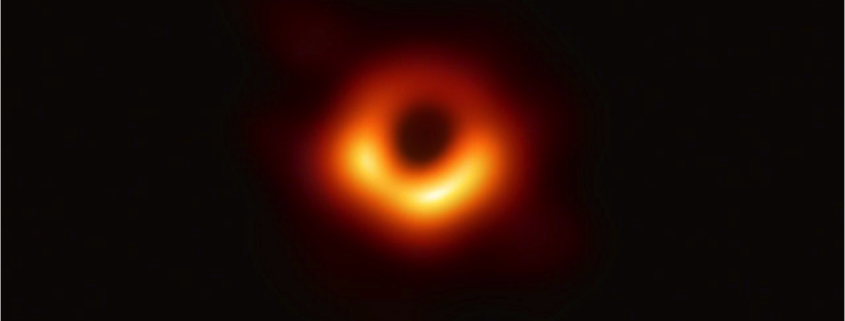For the first time, astronomers have managed to take a photo of a supermassive black hole and its shadow. They used the Event Horizon Telescope (EHT), a worldwide network of eight radio telescopes, that together form a virtual telescope the size of the earth. The news was presented in six press conferences around the world simultaneously.
Radboud University is represented in the management of the EHT. Astronomers from Nijmegen, the University of Amsterdam, Leiden University, and JIVE are involved in the project, as well as the NOVA-technical submm-group of the University of Groningen.
The results will be published in six scientific articles in a special edition of Astrophysical Journal Letters. The photo shows the black hole at the centre of Messier 87, a massive galaxy in the nearby Virgo galaxy cluster. This black hole is 55 million light-years from earth and is 6.5 billion times the mass of the Sun.
Interlinking the eight telescopes has resulted in unprecedented sensitivity and resolution. Time after time, independent observations with the EHT, using different imaging techniques, have revealed a circular-type structure, with a dark area in the middle, a shadow of the black hole in M87.
“Scientists from all over the world have worked together”, says Prof. Anton Zensus of MPIfR in Bonn, chair of the EHT management. The director of the EHT Project, Sheperd S. Doeleman of the American Harvard/Smithsonian Center for Astrophysics, speaks of “a milestone in astronomy, achieved with a team of over 200 researchers from 18 countries”.
Simulation of the Messier 87 black hole, made by Radboud astrophysicist Jordy Davelaar
In the beginning
Heino Falcke, Professor of Astroparticle Physics and Radio Astronomy at Radboud University, is the chair of the EHT Science Council and was there when the idea to photograph a black hole using a network of telescopes was first proposed. “If the black hole exists in a bright area, such as a disc of glowing gas, we expect that it will create a very dark area, comparable to a shadow. We have also compared the photo with supercomputer simulations of different black-hole models. These simulations match up surprisingly well with the observations and make it possible to determine the characteristics of the black hole.”
The shadow is created by deflection of the light caused by the curvature of space and by the absorption of light in the so-called event horizon of the black hole. The horizon is the edge of the area from which nothing, not even light, can escape from the black hole. Falcke: “Shape and size of the shadow perfectly match our expectations based on Einstein’s general theory of relativity and the existence of an event horizon.”
Exotic objects
Black holes are exotic cosmic objects which have enormous mass, but are small in size. A black hole exerts extreme influence on its environment. It curves spacetime and heats surrounding matter to super-high temperatures. “The size of the shadow is related to the mass of a black hole and we managed to actually measure the enormous mass of the black hole in M87”, says Sera Markoff, Professor of Astrophysics in Amsterdam, who is a member of the EHT Science Council and coordinator of the Multiwavelength Working Group.
“We know that black holes exert an enormous influence over their surroundings, at scales hundreds of millions times bigger than those of its event horizon. Using the EHT, we have been able to observe the origin of this process for the first time”, adds Markoff.
New instrument
With the EHT, scientists have a new instrument to study the most extreme objects in the universe, which were predicted by Einstein. The result comes exactly 100 years after the experiment that first proved Einstein’s theory.
Project manager of the EHT Project Remo Tilanus (Leiden University and Radboud University) is delighted: “This fantastic result follows years of hard work by teams all over the world to technically realise the EHT and have it ready for the observations by 2017. This has been a golden year: not only did everything work smoothly, but the weather was perfect everywhere too.”
Team work
At Radboud University itself, a team of 10 researchers and students, co-managed by astrophysicists Monika Moscibrodzka and Ciriaco Goddi, have worked hard over the past two years to achieve this result. They took part in the observations with the different telescopes and made a crucial contribution to the data analysis and the development of the theoretical models.
Important contributions were provided by the University of Amsterdam in the area of modelling and interpretation, by the Allegro group of the Leiden Observatory in relation to the calibration of the observations, by JIVE in the field of data-analysis software, and by the NOVA submm group of the University of Groningen in relation to specialised equipment.
The next step
Falcke is looking forward to achieving clearer imaging after upgrades in the network. “It is the beginning of a new era in which the ultimate limit of space and time is no longer an abstract concept, but a measurable reality. To increase the sensitivity, we want to expand the EHT network and build a millimetre telescope in Africa. We are fortunate to already have the first supports in place, from different parties and even businesses.”
More information
Heino Falcke received the Spinoza prize from the Netherlands Organisation for Scientific Research (NWO) in 2012 and a large grant from the European Research Council in 2013, which facilitated the research of the BlackHoleCam group. This Synergy Grant of €14 million was awarded to Falcke and co-principle investigators Luciano Rezzolla (Goethe Universiteit Frankfurt) and Michael Kramer (Max-Planck Instituut Bonn). Partner institutes are JIVE, IRAM, MPE Garching, IRA/INAF Bologna, SKA and ESO. The BlackHoleCam team is part of the EHT.
All astronomers from the Netherlands who are involved with the Event Horizon Telescope are listed here.
Originally published in the Radboud University News page of the Astronomy Department– Apr 10, 2019






